2.7: Solve Linear Inequalities
( \newcommand{\kernel}{\mathrm{null}\,}\)
By the end of this section, you will be able to:
- Graph inequalities on the number line
- Solve inequalities using the Subtraction and Addition Properties of inequality
- Solve inequalities using the Division and Multiplication Properties of inequality
- Solve inequalities that require simplification
- Translate to an inequality and solve
Before you get started, take this readiness quiz.
- Translate from algebra to English:
If you missed this problem, review Exercise 1.3.1. - Solve:
If you missed this problem, review Exercise 2.1.7. - Solve:
If you missed this problem, review Exercise 2.2.1. - Solve:
If you missed this problem, review Exercise 2.3.22.
Graph Inequalities on the Number Line
Do you remember what it means for a number to be a solution to an equation? A solution of an equation is a value of a variable that makes a true statement when substituted into the equation.
What about the solution of an inequality? What number would make the inequality
We show the solutions to the inequality

The graph of the inequality

Notice that the open parentheses symbol, (, shows that the endpoint of the inequality is not included. The open bracket symbol, [, shows that the endpoint is included.
Graph on the number line:
- Answer
-
1.

2.

3.

Graph on the number line:
- Answer
-
Graph on the number line:
- Answer
-
We can also represent inequalities using interval notation. As we saw above, the inequality

The inequality


Did you notice how the parenthesis or bracket in the interval notation matches the symbol at the endpoint of the arrow? These relationships are shown in Figure

Graph on the number line and write in interval notation.
- Answer
-
1.
2.
Shade to the right of −3, and put a bracket at −3. 
Write in interval notation. 
3.
Shade to the left of 2.5, and put a parenthesis at 2.5. 
Write in interval notation. 

Shade to the left of 
Write in interval notation. 
Graph on the number line and write in interval notation:
- Answer
-
Graph on the number line and write in interval notation:
- Answer
-
Solve Inequalities using the Subtraction and Addition Properties of Inequality
The Subtraction and Addition Properties of Equality state that if two quantities are equal, when we add or subtract the same amount from both quantities, the results will be equal.
Similar properties hold true for inequalities.
| For example, we know that −4 is less than 2. |  |
| If we subtract 5 from both quantities, is the left side still less than the right side? |  |
| We get −9 on the left and −3 on the right. |  |
| And we know −9 is less than −3. |  |
|
The inequality sign stayed the same. |
Similarly we could show that the inequality also stays the same for addition.
This leads us to the Subtraction and Addition Properties of Inequality.
We use these properties to solve inequalities, taking the same steps we used to solve equations. Solving the inequality
Any number greater than 4 is a solution to this inequality.
Solve the inequality
- Answer
-

Add 
Simplify. 
Graph the solution on the number line. 
Write the solution in interval notation.
Solve the inequality, graph the solution on the number line, and write the solution in interval notation.
- Answer
-
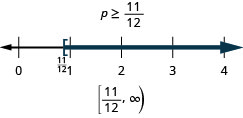
Solve the inequality, graph the solution on the number line, and write the solution in interval notation.
- Answer
-
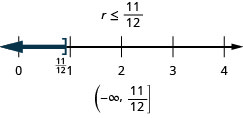
Solve Inequalities using the Division and Multiplication Properties of Inequality
The Division and Multiplication Properties of Equality state that if two quantities are equal, when we divide or multiply both quantities by the same amount, the results will also be equal (provided we don’t divide by 0).
Are there similar properties for inequalities? What happens to an inequality when we divide or multiply both sides by a constant?
Consider some numerical examples.
 |
 |
||
| Divide both sides by 5. |  |
Multiply both sides by 5. |  |
| Simplify. |  |
 |
|
| Fill in the inequality signs. |  |
 |
The inequality signs stayed the same.
Does the inequality stay the same when we divide or multiply by a negative number?
 |
 |
||
| Divide both sides by -5. |  |
Multiply both sides by -5. |  |
| Simplify. |  |
 |
|
| Fill in the inequality signs. |  |
 |
The inequality signs reversed their direction.
When we divide or multiply an inequality by a positive number, the inequality sign stays the same. When we divide or multiply an inequality by a negative number, the inequality sign reverses.
Here are the Division and Multiplication Properties of Inequality for easy reference.
For any real numbers a,b,c
When we divide or multiply an inequality by a:
- positive number, the inequality stays the same.
- negative number, the inequality reverses.
Solve the inequality
- Answer
-

Divide both sides of the inequality by 7.
Since
Simplify. 
Graph the solution on the number line. 
Write the solution in interval notation. 
Solve the inequality, graph the solution on the number line, and write the solution in interval notation.
- Answer
-

Solve the inequality, graph the solution on the number line, and write the solution in interval notation.
- Answer
-

Solve the inequality
- Answer
-

Divide both sides of the inequality by −10.
Since
Simplify. 
Graph the solution on the number line. 
Write the solution in interval notation. 
Solve each inequality, graph the solution on the number line, and write the solution in interval notation.
- Answer
-

Solve each inequality, graph the solution on the number line, and write the solution in interval notation.
- Answer
-

Sometimes when solving an inequality, the variable ends up on the right. We can rewrite the inequality in reverse to get the variable to the left.
Think about it as “If Xavier is taller than Alex, then Alex is shorter than Xavier.”
Solve the inequality
- Answer
-

Multiply both sides of the inequality by
Since
Simplify. 
Rewrite the variable on the left. 
Graph the solution on the number line. 
Write the solution in interval notation. 
Solve the inequality, graph the solution on the number line, and write the solution in interval notation.
- Answer
-

Solve the inequality, graph the solution on the number line, and write the solution in interval notation.
- Answer
-

Solve the inequality
- Answer
-

Multiply both sides of the inequality by −2.
Since
Simplify. 
Graph the solution on the number line. 
Write the solution in interval notation. 
Solve the inequality, graph the solution on the number line, and write the solution in interval notation.
- Answer
-

Solve the inequality, graph the solution on the number line, and write the solution in interval notation.
- Answer
-

Solve Inequalities That Require Simplification
Most inequalities will take more than one step to solve. We follow the same steps we used in the general strategy for solving linear equations, but be sure to pay close attention during multiplication or division.
Solve the inequality
- Answer
-

Subtract 9m from both sides to collect the variables on the left. 
Simplify. 
Divide both sides of the inequality by −5, and reverse the inequality. 
Simplify. 
Graph the solution on the number line. 
Write the solution in interval notation. 
Solve the inequality
- Answer
-
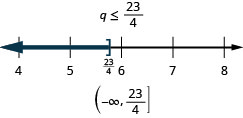
Solve the inequality
- Answer
-
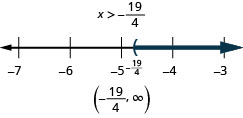
Solve the inequality
- Answer
-
Simplify each side as much as possible. 8p+3(p−12)>7p−28 Distribute. 8p+3p−36>7p−28 Combine like terms. 11p−36>7p−28 Subtract 7p from both sides to collect the variables on the left. 11p−36−7p>7p−28−7p Simplify. 4p−36>−28 Add 36 to both sides to collect the constants on the right. 4p−36+36>−28+36 Simplify. 4p>8 Divide both sides of the inequality by 4; the inequality stays the same. Simplify. Graph the solution on the number line. 
Write the solution in interval notation.
Solve the inequality
- Answer
-

Solve the inequality
- Answer
-

Just like some equations are identities and some are contradictions, inequalities may be identities or contradictions, too. We recognize these forms when we are left with only constants as we solve the inequality. If the result is a true statement, we have an identity. If the result is a false statement, we have a contradiction.
Solve the inequality
- Answer
-
Simplify each side as much as possible. 8x−2(5−x)<4(x+9)+6x Distribute. 8x−10+2x<4x+36+6x Combine like terms. 10x−10<10x+36 Subtract 10x from both sides to collect the variables on the left. 10x−10−10x<10x+36−10x Simplify. −10<36 The xx’s are gone, and we have a true statement. The inequality is an identity.
The solution is all real numbers.Graph the solution on the number line. 
Write the solution in interval notation.
Solve the inequality
- Answer
-

Solve the inequality
- Answer
-

Solve the inequality
- Answer
-

Multiply both sides by the LCD, 24, to clear the fractions. 
Simplify. 
Combine like terms. 
Subtract 5a from both sides to collect the variables on the left. 
Simplify. 
The statement is false! The inequality is a contradiction. There is no solution. Graph the solution on the number line. 
Write the solution in interval notation. There is no solution.
Solve the inequality
- Answer
-

Solve the inequality
- Answer
-

Translate to an Inequality and Solve
To translate English sentences into inequalities, we need to recognize the phrases that indicate the inequality. Some words are easy, like ‘more than’ and ‘less than’. But others are not as obvious.
Think about the phrase ‘at least’ – what does it mean to be ‘at least 21 years old’? It means 21 or more. The phrase ‘at least’ is the same as ‘greater than or equal to’.
Table
| > | < | ||
|---|---|---|---|
| " data-valign="middle" class="lt-math-15134">is greater than | is greater than or equal to | is less than | is less than or equal to |
| " data-valign="middle" class="lt-math-15134">is more than | is at least | is smaller than | is at most |
| " data-valign="middle" class="lt-math-15134">is larger than | is no less than | has fewer than | is no more than |
| " data-valign="middle" class="lt-math-15134">exceeds | is the minimum | is lower than | is the maximum |
Translate and solve. Then write the solution in interval notation and graph on the number line.
Twelve times c is no more than 96.
- Answer
-
Translate. 
Solve—divide both sides by 12. 
Simplify. 
Write in interval notation. 
Graph on the number line. 
Translate and solve. Then write the solution in interval notation and graph on the number line.
Twenty times y is at most 100
- Answer
-
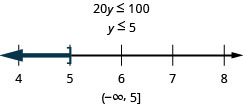
Translate and solve. Then write the solution in interval notation and graph on the number line.
Nine times z is no less than 135
- Answer
-
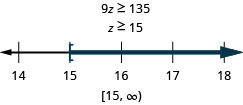
Translate and solve. Then write the solution in interval notation and graph on the number line.
Thirty less than x is at least 45.
- Answer
-
Translate. 
Solve—add 30 to both sides. 
Simplify. 
Write in interval notation. 
Graph on the number line. 
Translate and solve. Then write the solution in interval notation and graph on the number line.
Nineteen less than p is no less than 47
- Answer
-
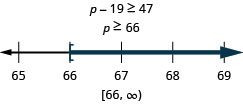
Translate and solve. Then write the solution in interval notation and graph on the number line.
Four more than a is at most 15.
- Answer
-
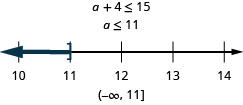
Key Concepts
- Subtraction Property of Inequality
For any numbers a, b, and c,
if a<b then a−c<b−c and
if a>b then a−c>b−c. - Addition Property of Inequality
For any numbers a, b, and c,
if a<b then a+c<b+c and
if a>b then a+c>b+c. - Division and Multiplication Properties of Inequality
For any numbers a, b, and c,
if a<b and c>0, then ac<bc and ac>bc.
if a>b and c>0, then ac>bc and ac>bc.
if a<b and c<0, then ac>bc and ac>bc.
if a>b and c<0, then ac<bc and ac<bc. - When we divide or multiply an inequality by a:
- positive number, the inequality stays the same.
- negative number, the inequality reverses.














